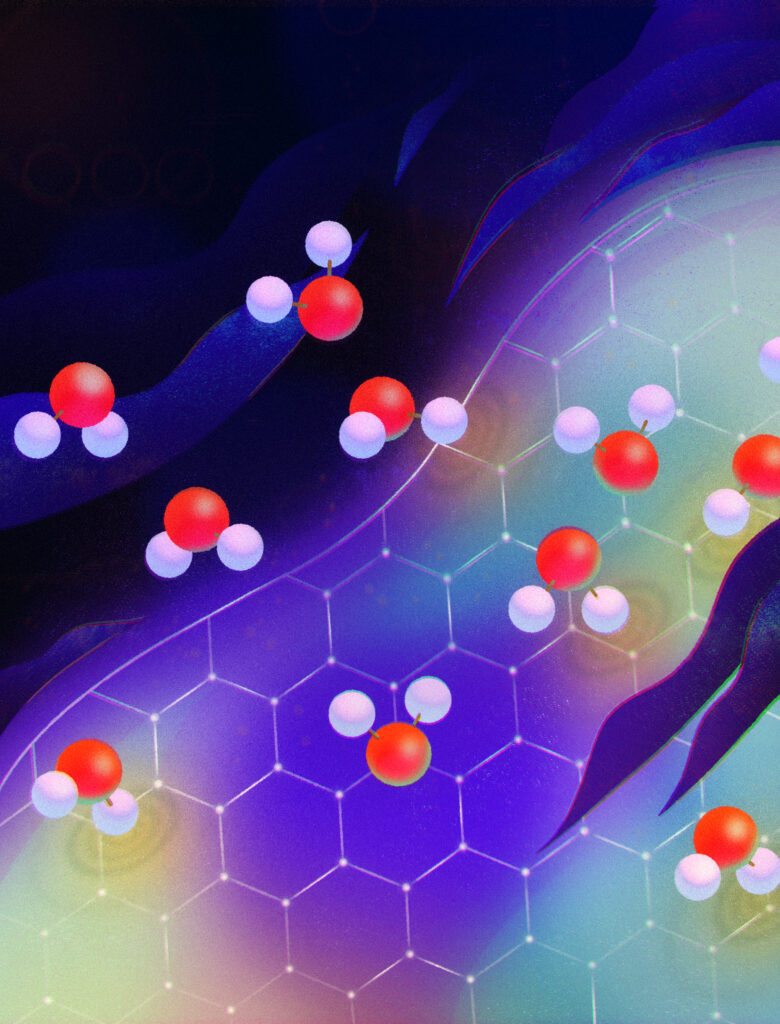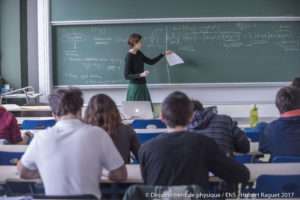Introduction

Lately the team has predicted a new quantum contribution to the solid-liquid friction force, that results from the coupling of water charge fluctuations to the electronic excitations within the solid. Eventually this new theory has rationalized the experimental observation of radius-dependent water slippage in carbon nanotube. More importantly this unravels a paradigm change for nanoscale hydrodynamics that the team is now exploring within an european projet “ERC Synergy n-aqua” shared with Mainz and Cambridge teams.
Theory
Our team uses analytical and numerical methods to model and study nanofluidic phenomena. On the analytical side, our tools cover a wide range of physics, from non-equilibrium statistical physics to perturbative quantum field theory, via classical fluid mechanics. On the numerical side, we work at all scales, from DFT (electron density functional theory), which describes matter at the level of atomic electron orbitals, through classical molecular dynamics (MD) to the resolution of macroscopic PDEs.
Experimental
Our team uses state-of-the-art experimental methods to study nanofluidics. We are able to fabricate nanoscale channels by van der waals assembly in a clean room, using materials such as graphene and graphite. We then make nanofluidic transport measurements using mainly water, salt, glycerol and ionic liquids. For these measurements, we use a variety of in-house tools, including atomic force microscopes (AFM), a confocal microscope and various electrical measuring devices.
Innovation
Our team is also interested in the practical applications of its nanofluidic discoveries. Working in particular on the development of atomic force microscopes (AFM) and the fabrication of membranes from 2D materials, we are transforming the understanding of nanometric scales into innovative, patented macroscopic devices to solve industrial and ecological problems.
Quantum Interfaces

Credits: Maggie Chiang (Simons Foundation)
“Massive radius-dependent flow slippage in single carbon nanotubes ” E. Secchi, S. Marbach, A. Niguès, D. Stein, A. Siria and L. Bocquet, Nature 537 210 (2016)
Nanofluidic Memory et Iontronics

Interfaces with Molecules


In liquid water conditions, the role played by interface chemistry becomes preponderant at nanoscales and nanofluidic transport is a source of questions at the interface between quantum chemistry and condensed matter. Using ab initio dynamics methods to simulate the solvent water explicitly, we recently showed unexpected “reactive” quantum effects at the interface of 2D nanomaterials and water, such as the peculiar interaction of solvated OH- ions at the graphene surface or the facile dehydration of a graphene oxide sheet.
“Spin in a Closed‐Shell Organic Molecule on a Metal Substrate Generated by a Sigmatropic Reaction”, Bocquet, M.-L., Lorente, N., Berndt, R., Gruber, M., Angewandte Chemie, 58, 821-824 (2019)
“Versatile electrification of two-dimensional nanomaterials in water”, Grosjean, B., Bocquet, M.-L., Vuilleumier, R., Nature
Communications, 10 (1), art. no. 1656 (2019)
“Structure and chemistry of graphene oxide in liquid water from first principles”, Mouhat, F., Coudert, F.-X., Bocquet, M.-L., Nature Communications, 11 (1), art. no. 1566 (2020)
Applications at Macro-Scales :
Desalination, Filtration and Blue Energy

“New avenues for the large scale harvesting of blue energy” A. Siria, M.-L. Bocquet and L. Bocquet, Nature Reviews Chemistry 1 0091 (2017)
Start-up
Sweetch Energy

UPI

Hummink

Hummink uses a patented technology that combines a nanometric “pen” with an oscillating macroresonator to perform a capillary deposition of various liquids. The system’s movement adapts to the specificities coming from either the ink or the substrate thanks to a unique electronic control. You can deposit virtually anything on anything. Discover more.










